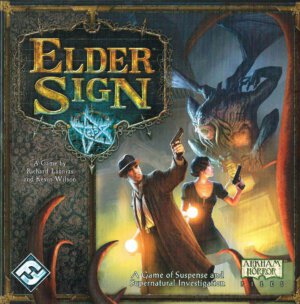
Publisher: Fantasy Flight Games
Designers: Richard Launius and Kevin Wilson
Artist: Dallas Mehlhoff
Year: 2011
Players: One to eight players
Ages: 13+
Playing Time: One to two hours
Category: Horror Dice/Card Game
MSRP: $34.95
Elder Sign has been referred to as “Arkham Horror lite” or “Arkham Yahtzee”. While both are accurate to a certain extent, they don’t really convey a sense of the game. The theme from Arkham Horror is there and so are dice rolling mechanics.
As a big fan of Arkham Horror and the Cthulhu Mythos, I admit a bit of a bias. I do feel that I can provide a decent overview and where the game could use some improvement.
The components are excellent and of the same high quality that you expect from FFG. The cards and artwork and flavor text are very thematic and convey the Mythos theme. The dice are custom and feature an array of icons representing investigation, terror, peril, and lore results. These results are used to complete the different tasks on the adventure cards.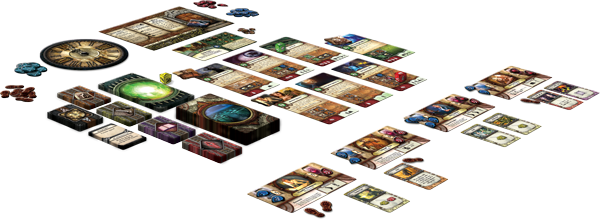
The object of the game is for the players to use their investigators to collect enough Elder Sign tokens to defeat the Great Old One that was selected for the game. Each Great Old One has a number listed on it representing the number of Elder Sign tokens needed. There is also a doom track on each Great Old One where doom tokens are placed throughout the game. If this track fills up, then the Great Old One wakes up and there is a final pitched battle between the investigators and the Great Old One to determine the victor.
There are 16 investigator cards and tokens included in the game, which you will recognize from Arkham Horror. The cards list the investigators stamina and sanity scores which will be reduced throughout the game by various cards. If an investigators sanity or stamina is reduced to zero, the investigator is devoured and out of the game. The player must select a new investigator. There are tokens to represent the player’s current stamina and sanity levels.
Each investigator also starts with certain item cards; either common, unique, spell or ally cards. In most cases these will allow a player to roll one of the extra red or yellow bonus dice when trying to complete a task on an adventure card.
The adventure cards are the crux of the game. In the beginning, six of these are placed on the table along with the 12 hour clock and the standard entrance card. During a player’s turn they will move to either one of the adventure cards or to the entrance card where they can perform several special actions like healing or gaining new item cards.
If a player moves to an adventure card, they will see several rows of icons. These represent the icons the player must roll to complete each task. Each row of icons is a single task. The player takes the six green dice and rolls them, then looks to see if he has the proper combination of dice to complete one of the tasks on the adventure card. If they do, they place those dice on the card and then roll the remaining dice to attempt to complete the next task. This continues until they fail to complete or finish all the tasks on the card. You are allowed to roll again if you miss, but you lose one die each time you do until you don’t have enough dice to complete all of the tasks.
You can save one die as a “Focus” die, allowing you to carry one result over to another roll if you fail. There are rules for other players assisting as well by saving one result on their investigator if they happen to be on the same card as you.
If you run out of dice, you fail the card. You suffer the penalty listed at the bottom of the card, which is normally sanity or stamina loss, or worse. If they complete all of the tasks, the player receives the rewards listed on the bottom of the card, which is usually item cards, but can result in a monster appearing or a gate to another world opening up. The player also receives the adventure card itself as a trophy that they can trade in later at the entrance for some new cards or other benefits.
Some of the adventure cards have Elder Sign marks listed under the rewards, and this is how you collect the tokens in order to win the game.
There are monster tokens as well. Various things can happen to make a monster appear. These monsters have their own icons on them that need to be rolled and become an additional task that the players must complete on an adventure card before that card is completed. Some adventure cards have special spots for monsters that you must fill up first. If you run out of these then future monsters are placed at the bottom of an adventure card of your choice.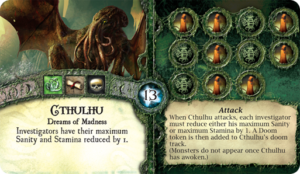
Completed adventure cards are replaced from the deck, and then the player takes care of the last major mechanic in the game. The clock is advanced three hours. Each time the clock hits 12 o’clock; a mythos card is drawn from the mythos deck and resolved. These usually provide one immediate bad thing that happens to all players, and one thing that lasts until the next mythos card is draw, also typically bad in some way. This is how the doom track fills up on the Great Old One’s card, although other things can happen to add tokens to the doom track as well.
If you gain enough Elder Sign tokens, you win, if not the Great Old One wakes up and you do battle following the instructions on his card. You will either all defeat him together or lose together as it is a cooperative game.
The game is simple enough in essence. The rules leave a lot of room for interpretation though as they do not explain many of the individual card effects or player’s abilities. So these are up to interpretation at this point as there is no word from FFG as yet. For example, Mandy Thompson allows you “Once per turn to re-roll 2 dice before determining if the active player is able to complete a task”. Once each players turn? Does she get to reroll dice for other players? This seems like it is a really nice benefit, but the intent of the designers was to allow her to roll once per each complete revolution of the clock. You wouldn’t ever figure that out from the card though.
The clock is the only mechanic for controlling difficulty for the number of players. It will trigger pulling a mythos card every fourth turn regardless as to how many people are playing. This may be enough, I haven’t made a decision on this yet, but I will say that down time does increase as the number of players go up. This is typical for most games, but the most balanced fun seems to come in the 4-5 player range. Yes, you are all involved as it is a coop game, but there is only so much you can discuss with the other players before you select an adventure card and start rolling.
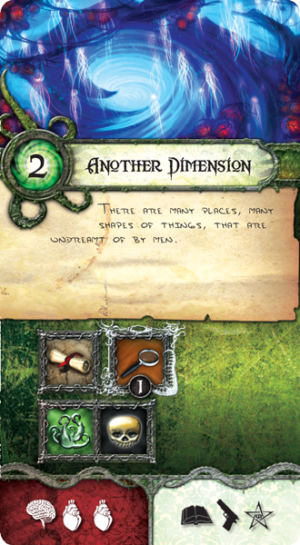
There definitely need to be a mechanic to make it bad to ignore adventure cards for too long. There are ways it can be accomplished, like adding tokens to adventure cards each time the clock strikes 12, and then when a certain number accumulate they are exchanged for a doom token on the Great Old One’s track.
Another method for avoiding monster burn is to have a card labeled “The Outskirts” ala Arkham Horror. Additional non-placeable monsters go in the Outskirts, which are then moved to adventure cards as new cards with spots for monsters are drawn. If a certain amount of monsters gather in the outskirts, they are removed and exchanged for a doom token that is placed on the doom track. Or, you can simply add a rule that you must distribute monsters as evenly as possible among the cards.
I think they could also add a mechanic for flying monsters as in Arkham Horror, having a “Sky” card where the flying monsters gather and can swoop down on an investigator on an adventure card, possibly by adding a flying monster die. This might be a good idea for an expansion.
A note on the clock, the rules and some cards refer to “Midnight”, but the clock is a twelve hour clock and we all know there is 24 hours in the day. The intent is that each time the clock reaches 12 a mythos card is drawn, or in play effects occur. So generally every four turns, not every eight.
Don’t get me wrong, this is a fun game and it plays in about an hour. If you are a Mythos fan or dice games fan this is a great way to “gateway” new players toward playing Arkham Horror. If the luck of the die roll isn’t your bag then you will not enjoy the game. Many have complained that the game is too easy, but I don’t agree. Bad die rolls can quickly lead to bad things happening, and you do get some satisfaction from defeating the Great Old One. If you don’t burn the extra monsters all on one card, then you do face more of a challenge. You also need to make sure to advance that clock when you are supposed to, as it is easy to forget and thus make the game that much easier.
- A Dungeon Delve for Kids?: A Review of Dungeon! - Oct 24, 2022
- Better, Stronger, Faster | Descent: Journeys in the Dark Second Edition Reviewed - Oct 23, 2022
- Your Planet is Doomed!: Invasion from Outer Space Reviewed - Oct 22, 2022



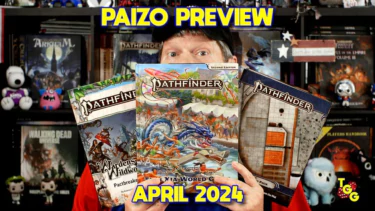
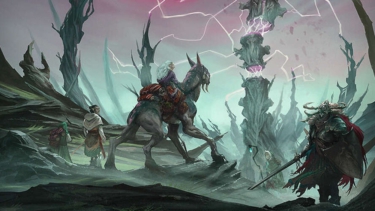
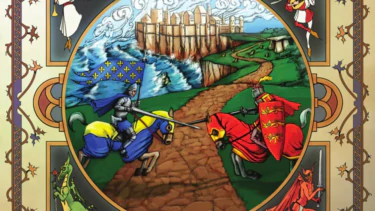
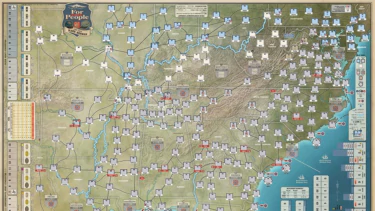


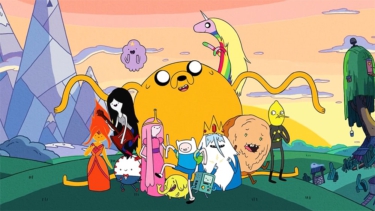
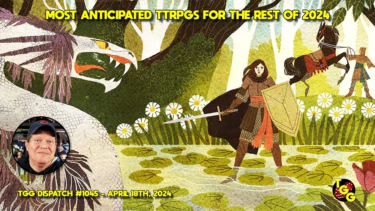
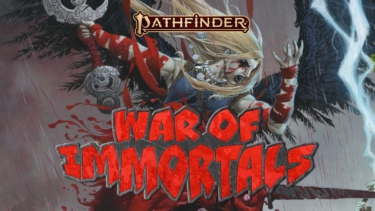
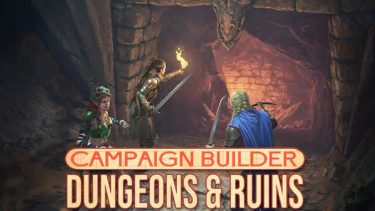
5 Comments
Did we just rock the Ace of Base reference for the title? Yeah I believe that’s what just happened.
And people thought we only toss out obscure references on the podcast. 🙂
Give it a rest Groucho. 😛
At least this reference is only 16 years old, I’ve been trying to figure out a way to work in “Last night, I shot an elephant in my pajamas”
A new Faq has been published on the FFG website. Essentially it corrects everything you said on this review.
Hope that helps! 🙂